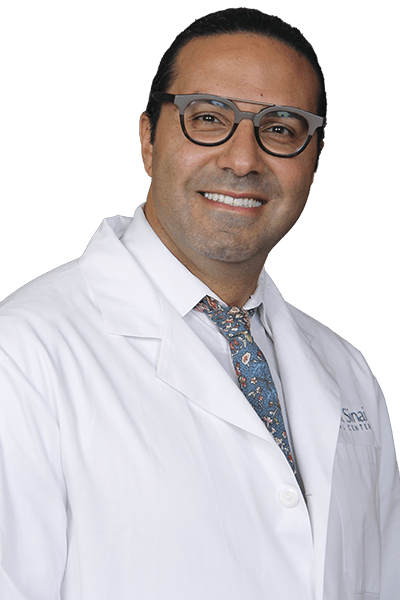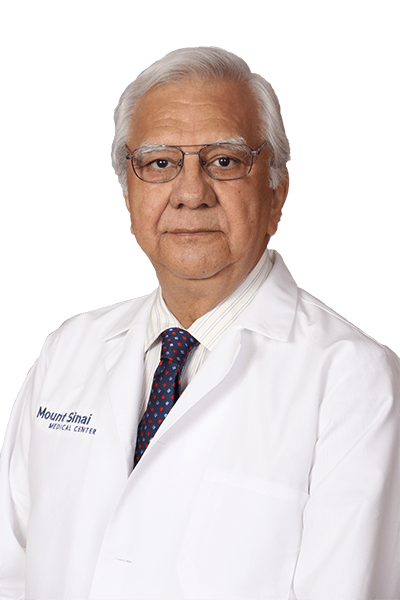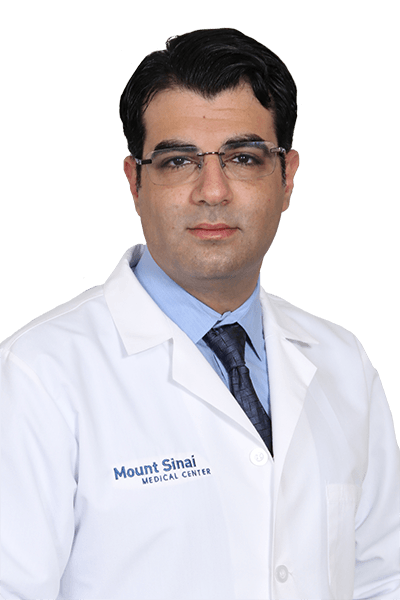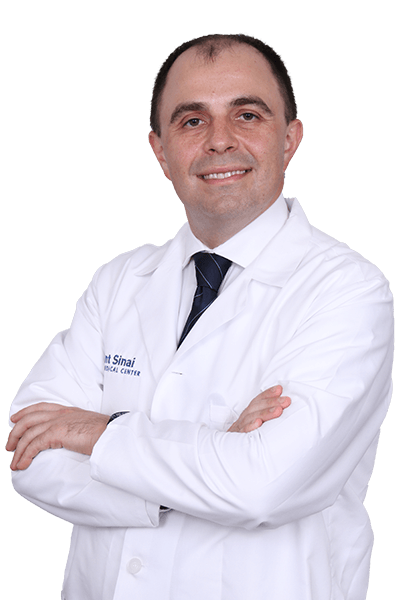What We Treat
Mount Sinai is committed to delivering exceptional, compassionate care that improves clinical outcomes and quality of life for individuals with vascular disease. Vascular disease refers to any condition in which fatty deposits in the blood stick to blood vessel walls and restrict blood flow.
Over time, the heart has to work harder to pump blood through the body, increasing the risk for heart attack and stroke. Poor circulation also impairs the body’s natural ability to heal, especially in the hands and feet of patients with uncontrolled diabetes. Small cuts can quickly develop into ulcers or wounds that, if left untreated, can lead to infection or even amputation.
Aortic Disease
Aortoiliac occlusive disease (AIOD) is a condition that results in the narrowing of the main artery (aorta) that arises from the heart and supplies blood to the rest of the body. Similar to peripheral arterial disease (PAD), a build-up of calcium, cholesterol, platelets, and other debris (plaques) blocks the blood flow as it travels to vital organs and the arteries of the legs, arms, and brain. The blockage can be partial or complete and is the result of these plaques breaking apart with debris and clots traveling or embolizing to vessels in the limbs, other organs, and brain. If the plaques are large enough, they decrease the size or pinch off the vessel. A reduction of blood flow to the extremities occurs, which creates muscle cramps and pain, also called claudication, primarily in the legs. The pain is usually worse when walking. Risk factors for aortic disease are high blood pressure, elevated cholesterol and triglycerides, diabetes, and smoking.Arterial Disease (PVD/PAD)
Peripheral vascular disease (PVD), also known as peripheral arterial disease (PAD), is a circulation problem caused by the narrowing of blood vessels to parts of the body other than the brain and heart. As in aortic disease, the causes are due to atherosclerosis (plaque) from elevated cholesterol, blood clots, diabetes, and inflammation or injury to the blood vessels. Obesity, hypertension, smoking, diabetes, high LDL or “bad” cholesterol, low blood HDL or “good” cholesterol, and elevated triglycerides are risk factors for PVD.
Symptoms of PVD include leg cramps and dull aching in the calves, thighs, or hips when walking. This is known as intermittent claudication. Other symptoms include numbness or tingling in the legs, buttock pain, weakness, burning or aching in the feet or toes while resting, poorly healing sores, hair loss on legs, and impotence. In addition, the legs may feel cool or change color.
There are a few tests used to diagnose PVD, such as an ankle/brachial index, ultrasonography, magnetic resonance imaging, and angiography, which is an examination of blood or lymph vessels by X-ray. Complications of PVD include permanent numbness, tingling, or weakness in the legs and feet; permanent burning or aching in the legs and feet; tissue death or gangrene that may require amputation; and a higher risk of heart attack and stroke.
Carotid Artery Disease (CAD)
Carotid artery disease (CAD) is caused by a build-up of a waxy/fatty substance called plaque inside the carotid arteries. You have two common carotid arteries, one on each side of your neck, which divide into internal and external carotid arteries on each side. The internal carotid arteries supply blood rich in oxygen to your brain, while the external carotid arteries supply blood rich in oxygen to your neck, face, and scalp.
Any time oxygen is reduced in the brain, a stroke can occur, which causes brain cells to die. Like a heart attack, when the heart muscle is deprived of oxygen, a stroke is also known as a brain attack. It is a leading cause of disability and death in the United States. Blockage and build-up occur gradually, and the first sign may be a transient ischemic attack (TIA), which is a temporary blockage or “mini” stroke. Many times, there are no early warning symptoms.
Signs and symptoms of an impending stroke include sudden numbness or weakness in the face or limbs, generally on one side of the body. Trouble speaking and visual problems are other symptoms. Dizziness, loss of balance, and headaches are common.
Like other places in the body where plaque builds up, the causes of CAD are elevated cholesterol, high blood pressure, diabetes, and smoking.
Chronic Wounds
Chronic wounds are a worldwide health problem and include diabetic foot ulcers, pressure ulcers, and venous leg ulcers. Causes include lack of oxygen, tissue death, diabetes, infection, or certain drugs. Other causes include arterial insufficiency, a circulation problem caused by the narrowing of blood vessels to parts of the body other than the brain and heart, tissue swelling, or lymphedema, neuropathy, pressure, cancer, and radiation damage. Chronic wounds can be found anywhere on the body, but tend to be more prevalent on the legs and feet, as well as areas of chronic pressure, including from prolonged bedrest.
Diabetic Ulcers
Diabetic foot ulcers occur as a result of a variety of factors, such as mechanical changes in the bony shape of the foot. They can also occur when the blood vessels become narrowed or when nerve damage occurs. Unnoticed excessive heat or cold, pressure from a poorly fitting shoe, or damage from a blunt or sharp object may cause blistering and ulceration. There may also be underlying peripheral artery disease that reduces blood flow and oxygen to the damaged tissue, all of which slows down the healing process for the ulcer.
Diabetic peripheral neuropathy is present in 60% of diabetic persons and 80% of diabetic persons with foot ulcers. Poor circulation and blood sugar control are other factors for ulcer development.
Venous Ulcers
Venous ulcers are also called nonhealing wounds or venous stasis ulcers. They are open wounds of the lower leg or ankle. They can cause leg swelling and cramping, dull ache, a tingling sensation, itchy skin, hardened skin, and purplish, red, or blue discoloration.
Venous ulcers are often caused by valvular problems in the venous system, which are the vessels that return blood to the heart. The valves in the veins help propel blood and lymphatic fluid back to the heart, and when they get weak or prolapse backwards, they prevent the fluid from moving in the right direction. This leads to excess fluid in the tissue, and the pressure leads to skin breakdown.
Varicose veins, venous hypertension, blood clots, diabetes, kidney failure, medications, infections, and obesity are other possible causes. They do not heal quickly and can last months or longer. The tissue can ooze with drainage and develop a yellow, fibrous (hardened and scarred) tissue with irregular borders.
Complicated Wounds Secondary to Surgery
Our multidisciplinary team of vascular surgeons and wound care surgeons addresses the cause of the wound and the wound healing process in a collaborative approach across all specialties.
Mesenteric and Renal Disease
Mesenteric and renal disease are caused by narrowing of the arteries that supply the intestines and the kidneys, respectively. They are caused by plaques, a build-up of calcium, cholesterol, platelets, and other debris. Another term for narrowing is stenosis. When this narrowing occurs, less oxygen is delivered to these organs, and they can become damaged.
When severe, kidney failure or bowel death can occur, which are medical emergencies. These conditions are found with other similar conditions such as heart disease and carotid artery disease. Advanced age, sedentary lifestyle, smoking, diabetes, high blood pressure, and excess cholesterol can lead to plaques that block the blood flow.
Symptoms of mesenteric disease are abdominal pain and cramping, which may lead to weight loss due to fear of eating because of the pain that comes after eating. Signs of renal disease may not be anything but high blood pressure. High blood pressure leads to vessel damage, and damage to the kidneys can lead to high blood pressure and kidney failure that requires dialysis or transplant. Another cause for narrowing found in renal arterial diseases is an overgrowth of muscle in the arterial wall.
Peripheral Artery Disease (PAD)
Peripheral heart disease, also known as peripheral vascular disease or peripheral artery disease (PAD), is a circulatory problem that decreases the flow of blood to the extremities, most notably in the legs and feet. It affects the blood vessels outside the heart, causing them to narrow and restrict the blood flow to the arms, legs, kidneys, or stomach. People with PAD often experience claudication, which is pain in the hip, thigh, or calf muscle when walking. Left untreated, it can lead to total loss of circulation to the legs and feet, resulting in sores, ulcers, and possible amputation.
PAD is often a sign of a more widespread atherosclerosis (the accumulation of fatty deposits in the arteries), which may be reducing blood flow to the heart and brain, increasing the risk of a heart attack or stroke.
Factors that increase the risk of developing PAD include:
- A family history of PAD, heart disease, or stroke
- Diabetes
- High blood pressure
- High cholesterol
- Increasing age, especially after reaching 50
- Obesity
- Smoking
Symptoms of PAD vary from person to person and may include:
- Altered sensations or feelings in the feet or legs, such as pain, cramping, burning, or tingling
- Cramping in the affected legs and in the buttocks, thighs, calves, and feet when walking, although it may subside with rest
- Open areas or sores on the ankles or feet that do not heal
Half of people who have PAD experience no symptoms at all.
Screening for PAD is quick and painless. The physician will first perform a physical examination of the legs. Next, he/she will place a cuff around the upper arm and the ankle to measure the blood pressure in both limbs. The systolic blood pressure at the ankle is divided by the systolic blood pressure at the arm to calculate ankle-brachial index (ABI). If the blood pressure in the ankle is less than 90 percent of the blood pressure in the arms, PAD is likely. The physician will order imaging tests to confirm the diagnosis and reveal the progression of PAD.
Varicose Veins
Varicose veins are enlarged, crooked, and/or bluish veins that bulge from the surface of the skin, usually in the legs and ankles. They occur when valves inside the veins are too weak and fail to push blood back up to the heart. When excess blood pools in the legs, it causes veins to stretch, twist, and bulge. Most cases of varicose veins are not serious, but they can cause painful symptoms or open sores that become infected.
Factors that increase the risk of developing varicose veins include:
- A family history of varicose veins
- Being female
- Increasing age
- Lack of exercise
- Malfunctioning vein valves
- Nutritional deficiencies
- Obesity
- Pregnancy
- Sitting or standing for long periods of time
- Wearing tight clothing, especially around the waist
Symptoms of varicose veins vary from person to person and may include:
- Calf pain after sitting or standing for long periods of time
- Dark blue, twisted, and bulging veins in the legs
- Heaviness, burning, and itching in the legs
- Open sores
- Pain and swelling in the legs, ankles, or feet
- Skin changes, including a change in color, dry or scaly skin, and thinning skin
Some people do not experience any symptoms.
Your physician will examine your legs and feet for signs of varicose veins, and ask whether you have experienced any lower extremity pain to determine if you have varicose veins. If the physician suspects more extensive vascular damage, they may order additional tests.
Venous Disease
Venous disease is caused by venous hypertension from failed valves inside veins. Patients with significant lower extremity symptoms have pain, skin irritation, swelling, and skin changes, and are at risk of developing debilitating venous ulceration and chronic inflammation.
Chronic venous insufficiency (CVI) can be caused by the absence of or damage to venous valves in veins. It can also be caused by clot formation, but it is rarely associated with varicose veins. Sometimes, for patients who were born with weak valves, valve failure can simply occur. Normal valves can also fail, and can be caused by direct trauma, thrombosis (blood clots), hormonal changes, or even prolonged standing.
Our Physicians
Micheal T Ayad, MD
Chief, Division of Vascular Surgery
Director, Vascular Institute
Co-Director, Aortic Center
- Endovascular Surgery
- Vascular Surgery
- Aortic Aneurysm Repair
- Mount Sinai Medical Center (Main Campus)
- 305.674.2906
- Mount Sinai Emergency Center, Physician Offices, Cancer Center and Diagnostic Center Aventura
- 305.692.1072
- Mount Sinai Specialty Care Key West I Cardiology, Urology & Vascular Care
- 305.294.8334
Manuel Sivina, MD
- General Surgery
- Vascular Surgery
- Mount Sinai Medical Center (Main Campus)
- 305.674.2121
Edward Andraos, MD
- Vascular Surgery
- Aortic Aneurysm Repair
- Mount Sinai Medical Center (Main Campus)
- 305.674.2071
- Mount Sinai Medical Center, Kenneth C. Griffin Center, Hialeah – Emergency Center and Primary & Specialty Care | Mount Sinai Eldercare
- 786.584.5555
- Mount Sinai Specialty Care Key West I Cardiology, Urology & Vascular Care
- 305.294.8334
Jacob Schwartzman MD, MPH, RPVI
- Vascular Surgery
- Mount Sinai Medical Center (Main Campus)
- 305.674.2906
- Mount Sinai Medical Center (Main Campus – 4302)
- 305.674.2121
- Mount Sinai Emergency Center, Physician Offices, Cancer Center and Diagnostic Center Aventura
- 305.692.1072
- Mount Sinai Specialty Care Key West I Cardiology, Urology & Vascular Care
- 305.294.8334
Stephen W Unger, MD
- General Surgery
- Vascular Surgery
- Mount Sinai Medical Center (Main Campus)
- 305.674.2121






